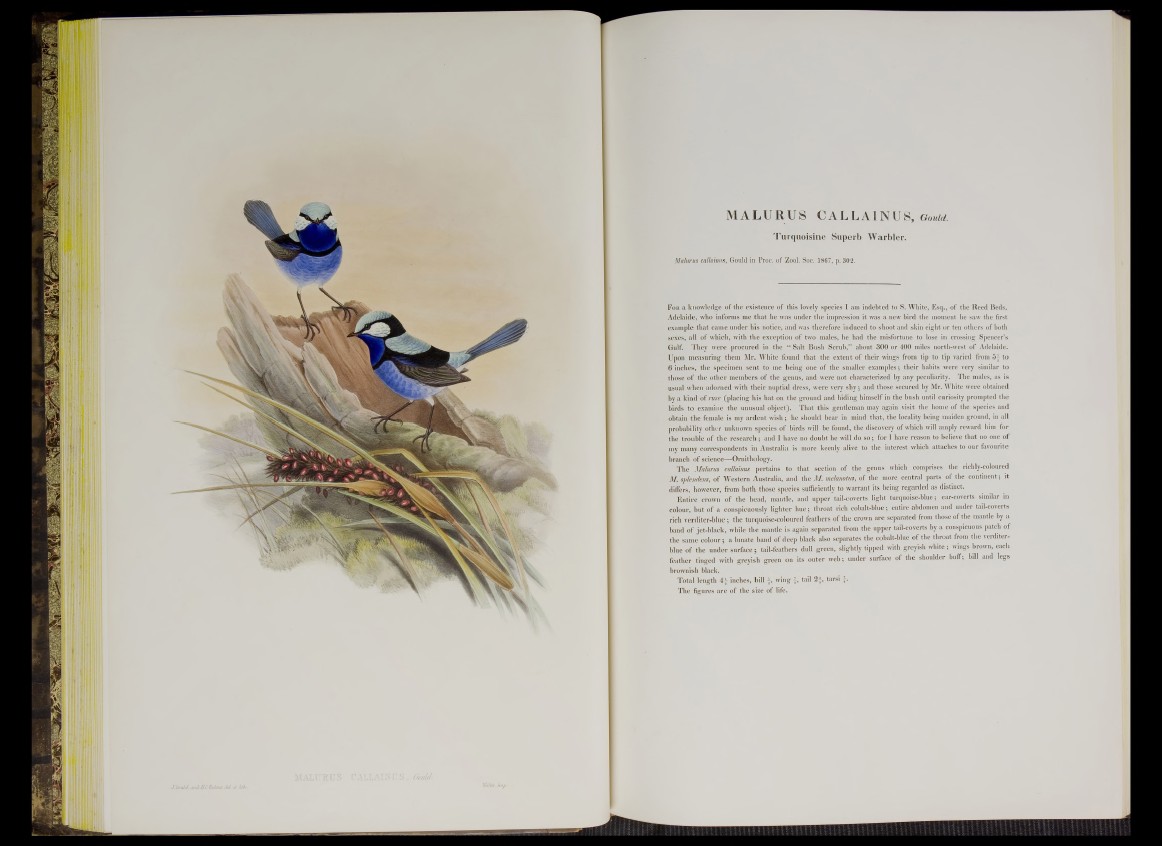
J.OmM arubECWaa-M & M u
MALURUS CALLAINUS, Gould.
Turquoisine Superb Warbler.
Malurus callainus, Gould in Proc. of Zool. Soc. 1867, p. 302.
For a knowledge of the existence of this lovely species I am indebted to S. White, Esq., of the Reed Beds,
Adelaide, who informs me that he was under the impression it was a new bird the moment he saw the first
example that came under his notice, and was therefore induced to shoot and skin eight or ten others of both
sexes, all of which, with the exception of two males, he had the misfortune to lose in crossing Spencer’s
Gulf. They were procured in the “ Salt Bush Scrub,” about 300 or 400 miles north-west of Adelaide.
Upon measuring them Mr. White found that the extent of their wiugs from tip to tip varied from to
6 inches, the specimen sent to me being one of the smaller examples; their habits were very similar to
those of the other members of the genus, and were not characterized by any peculiarity. The males, as is
usual when adorned with their nuptial dress, were very shy; and those secured by Mr. White were obtained
by a kind of ruse (placing his hat on the ground and hiding himself in the bush until curiosity prompted the
birds to examine the unusual object). That this gentleman may again visit the home of the species and
obtain the female is my ardent wish; he should bear in mind that, the locality being maiden ground, in all
probability other unknown species of birds will be found, the discovery of which will amply reward him for
the trouble of the research; and I have no doubt he will do s o ; for I have reason to believe that no one of
my many correspondents in Australia is more keenly alive to the interest which attaches to our favourite
branch of science—Ornithology.
The Malurus callainus pertains to that section of the genus which comprises the richly-coloured
M. splendens, of Western Australia, and the M. melanotus, of the more central parts of the continent; it
differs, however, from both those species sufficiently to warrant its being regarded as distinct.
Entire crown of the head, mantle, and upper tail-coverts light turquoise-blue; ear-coverts similar in
colour, but of a conspicuously lighter hue; throat rich cobalt-blue; entire abdomen and under tail-coverts
rich verditer-blue; the turquoise-coloured feathers of the crown are separated from those of the mantle by a
band of jet-black, while the mantle is again separated from the upper tail-coverts by a conspicuous patch of
the same colour; a lunate band of deep black also separates the cobalt-blue of the throat from the verditer-
blue of the under surface; tail-feathers dull green, slightly tipped with greyish white; wings brown, each
feather tinged with greyish green on its outer web; under surface of the shoulder buff; bill and legs
brownish black.
Total length 4^- inches, bill -j, wing f , tail 2f-, tarsi
The figures are of the size of life.